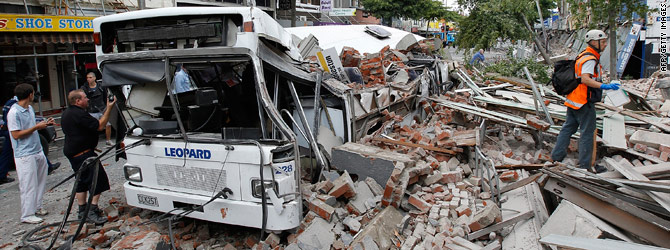 New Zealand's prime minister says at least 65 people have died after a 6.3-magnitude earthquake hit Christchurch.
New Zealand's prime minister says at least 65 people have died after a 6.3-magnitude earthquake hit Christchurch.
John Key said the toll was expected to rise further, adding: "We may be witnessing New Zealand's darkest day."
The tremor caused widespread damage as it occurred at lunchtime when Christchurch was at its busiest, at a shallow depth of 5km (3.1 miles).
The mayor of New Zealand's second-biggest city says at least 200 people are believed trapped under rubble.
The country's deadliest natural disaster in 80 years struck at 1251 (2351 GMT on Monday), 10km (6.2 miles) south-east of the city.
Screams from rubble
The damage is said to be far worse than after the 7.1-magnitude quake on 4 September, which left two people seriously injured but no fatalities.
That quake's epicentre was further away from the city and deeper underground, but still caused an estimated $3bn (£1.9bn) in damage.
TV pictures of the aftermath of Tuesday's disaster showed scores of collapsed buildings in the South Island city of nearly 400,000 people.
People could be seen wandering the rubble-strewn streets in distress.
Police said that among the dead were people on two buses which had been crushed by falling buildings.
Helicopters have been used to put out fires caused by the quake.
Officials said up to 30 people were feared still trapped inside the Pyne Gould Guinness building, where screams have been heard from beneath the wreckage.
'Warzone'
Local television showed bodies being pulled out of rubble.
Christchurch Cathedral, an iconic stone building in the centre of the city, was partly destroyed, its spire toppling into the square below.
Concrete in Victoria Square had risen at least a metre in some places and there are signs of liquefaction around the Avon river, RNZ added.
Power and telephone lines were knocked out, and pipes burst, flooding the streets with water.
The suburbs of Lyttleton and New Brighton are reportedly "unliveable".
Aftershocks
As night-time approached, emergency shelters were set up in the city's Hagley Park, a race course and schools.
Christchurch Mayor Bob Parker told the BBC: "We're beginning to get a feeling, from what we've got so far, that a significant number of people are injured and a significant number of people are still trapped in buildings.
"And as we get further into that rescue operation... clearly we're going to be presented with statistics that are going to be bleak."
PM John Key said: "It is just a scene of utter devastation. We have to work as fast as we can to get people out of environments where they are trapped.
"This is a community that is absolutely in agony. We just need this community, as it has done before and as it will do again, to come together, to check and support one another," he added.
The military has been deployed to help the rescue effort, and the government has accepted an offer of specialist help from Australia.
Two large magnitude-5 aftershocks have already rattled the stricken city, and officials warned residents to brace for more.
One Christchurch resident, Jaydn Katene, told the New Zealand Herald: "We've had friends in town call us and say there are just bodies lying around; lots of dead bodies outside shops just lying there just covered in bricks."
A British backpacker said the city "looked like a bomb had hit it".
New Zealand lies at the southern end of the so-called Pacific Ring of Fire, and above an area of the Earth's crust where the Pacific Plate converges with the Indo-Australian Plate.
The country experiences more than 14,000 earthquakes a year, of which only around 20 have a magnitude in excess of 5.0.
The last fatal earthquake was in 1968, when a 7.1-magnitude tremor killed three people on the South Island's western coast.
Tuesday's tremor was the country's worst natural disaster since a 1931 quake in the North Island city of Napier killed 256 people.



